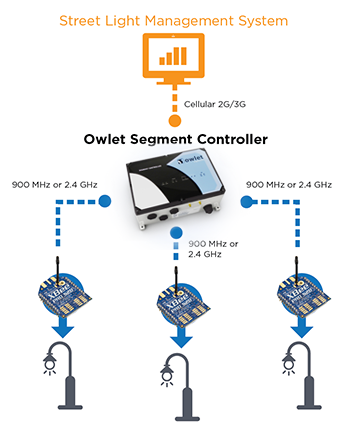Owlet Nightshift, developed by Schréder and headquartered in Mainz, Germany, supplies intelligent tele-management systems for monitoring and controlling outdoor and roadside lighting. They offer one of the simplest mast-to-bulb systems on the market; and can include other beneficial services from planning, training and design, to installation, setup and turn-key solutions, all tailor-made to customer requirements.
Business Challenge
Local municipalities need to keep their citizens safe and active by providing services and infrastructures that support healthy lifestyles. From controlling illumination on roadways for traffic to improving visibility on sidewalks for pedestrians, municipal lighting is one of the most valuable and necessary substructures.  However, most lighting systems are built on antiquated and inefficient technologies. They typically require large budgets and teams to maintain, especially in response to lighting failures. In fact, lighting maintenance can account for an astounding 40% of a city’s energy expenses! Owlet Nightshift feels that’s just too much waste.
However, most lighting systems are built on antiquated and inefficient technologies. They typically require large budgets and teams to maintain, especially in response to lighting failures. In fact, lighting maintenance can account for an astounding 40% of a city’s energy expenses! Owlet Nightshift feels that’s just too much waste.
With their experience in building lighting systems that contribute to the sustainable well-being of urban and rural communities, the team at Owlet knew that the high cost of lighting didn’t have to be the case in today’s connected world. They asked, “What if the lights in our cities could be intelligent and self-aware?” That being said, Owlet sought a partner to supply wireless technology that was both highly reliable and scalable to meet the requirements of an ever-expanding landscape.
“We needed a trusted partner, one with experience in creating complete M2M and IoT solutions,” said Ryan Morgan, Schréder’s North America marketing manager. “Digi not only had all the pieces we needed, they had the technical background and expertise to help us develop the strategy to bring the solution to life, and more importantly, to shorten the development cycle in order to bring the system to market in the most expeditious manner possible – and the module approach significantly reduces development times. Now that the system is up and running, we’re saving cities around the world hundreds of thousands of dollars a year in lighting energy costs.”

Solution
Using Digi connectivity hardware, Schréder created Owlet Nightshift, a solution that enables cities to retrofit aging lighting infrastructures with long-lasting intelligent technology. Each intelligent light is equipped with a high performance LED array and a Digi XBee ZigBee module. Digi XBee modules allow groups of lights to form a ZigBee Mesh network that connect to a cellular WAN through a Digi ConnectPort® X4 cellular gateway. Every node can then be centrally monitored and the lighting program can be changed by a technician at a desktop or handheld smart device using Owlet web-based management tools, anywhere with access to the Internet.
Thanks to Owlet, municipalities don’t need to wait for a citizen to report an outage or check for outages via scheduled inspections. The lights can now tell the city when they need to be serviced or replaced. They can even increase brightness on demand to compensate for a failure in the network while the issue is being repaired. Intelligent lights can sense when they need to be brighter, dimmer or even turned off completely, depending on the weather, traffic volume, pedestrian situation or time of day.
Results
Owlet Nightshift can help save cities up to 85% of their lighting energy costs, broken out as follows:
- Energy saving methods are already integrated into the software to make the base and most efficient use of LED technologies – savings of 8% to 10%.
- Instead of a traditional constant state of full output that consumes a great deal of energy, Owlet can dim LED arrays to levels appropriate for the conditions – savings of 25%.
- Customers can define dimming profiles to reduce light levels on roads at night when it is quiet, and then increase light during peak times, such as during rush hour – savings of 30%-40%.
- By reducing energy consumption, the system also helps protect the environment by reducing CO2 emissions.
Routine diagnostics can be executed from a centralized location to eliminate the need for road closures when workers used to visit and inspect every lighting location on the network. By creating such operational efficiencies, the Owlet solution will save municipalities up to a combined 90% on energy and maintenance costs.
Continuous fault monitoring further reduces maintenance costs, while system usage extends the life of LED arrays, further reducing costs. Today, maintenance teams driving across metropolitan areas to check lights is a thing of the past. When the system reports a problem, technicians can go directly to the lamp and repair it, or even choose to postpone repair until multiple units approach end-of-life or require system maintenance or cleaning.